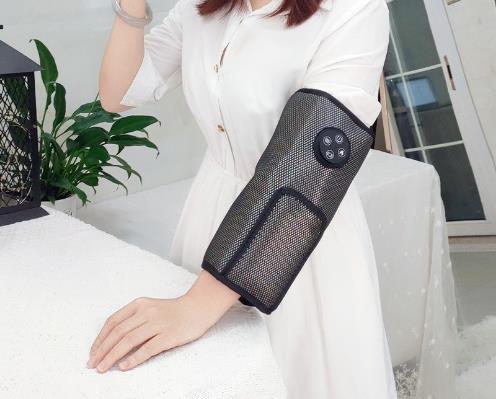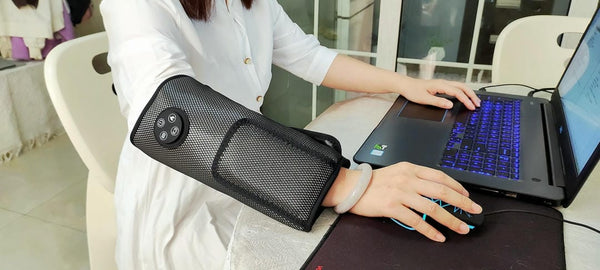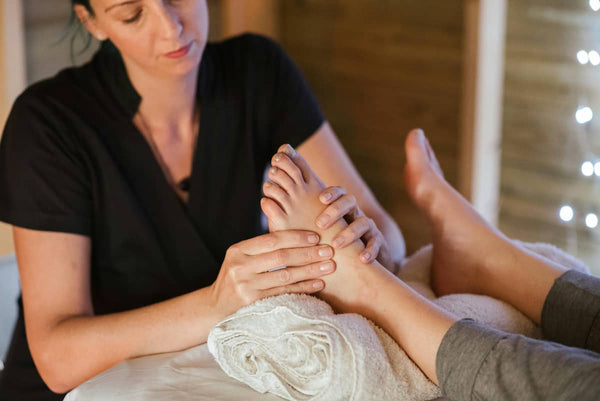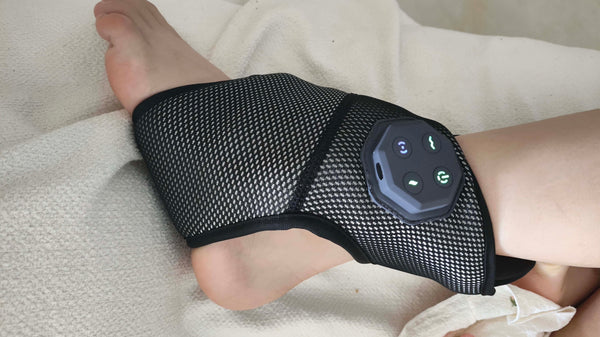 Are your feet whispering, or perhaps screaming, for a little TLC after a long day? You're certainly not alone! Approximately 77% of adults report foot pain at some point in their lives, a common ache that can really put a damper on your daily routine. As a rehabilitation physiotherapist, I've seen firsthand how crucial foot health is to overall well-being, especially for our active middle-aged and elderly fitness enthusiasts. A well-executed foot massage, whether by hand or with a trusty foot massager, isn't just a luxurious treat; it's a vital tool for improving circulation, reducing soreness, and boosting your mood. Let's dive into how you can master the art of the appropriate foot massage, ensuring every rub brings genuine relief and rejuvenation.
Are your feet whispering, or perhaps screaming, for a little TLC after a long day? You're certainly not alone! Approximately 77% of adults report foot pain at some point in their lives, a common ache that can really put a damper on your daily routine. As a rehabilitation physiotherapist, I've seen firsthand how crucial foot health is to overall well-being, especially for our active middle-aged and elderly fitness enthusiasts. A well-executed foot massage, whether by hand or with a trusty foot massager, isn't just a luxurious treat; it's a vital tool for improving circulation, reducing soreness, and boosting your mood. Let's dive into how you can master the art of the appropriate foot massage, ensuring every rub brings genuine relief and rejuvenation.
The Art of the Gentle Touch: How to Start Your Foot Massage Journey
When embarking on a foot massage, many people jump straight to deep kneading. However, based on my clinical experience, the secret to an effective session truly begins with a gentle, warming introduction. This initial phase helps prepare the muscles and connective tissues, signaling to your body that it's time to relax. It's like warming up before a good workout; you wouldn't just sprint cold, would you? Applying gentle pressure, especially around the toes and top of the foot, stimulates superficial nerve endings and increases local blood flow, paving the way for deeper work.
The physiological explanation is quite simple: gentle strokes activate mechanoreceptors in the skin, which then send calming signals to the brain, helping to decrease muscle tension and reduce the perception of pain. This approach is particularly suitable for individuals new to foot massage or those with sensitive feet, including elderly individuals who might have thinner skin or circulatory issues. It’s a wonderful way to ease into the experience, making it comfortable and enjoyable right from the start.
- Start with light stroking motions from the toes up to the ankle.
- Use your thumbs to gently circle the pads of the toes.
- Employ slow, rhythmic movements to encourage relaxation.
- Maintain consistent, but very light, pressure across the entire foot.
Unlocking Foot Bliss: Targeting the Arch with Precision Using Your Good Foot Rub Machine
Once you've set the stage with gentle strokes, it's time to focus on the arch – the true engineering marvel of the foot! This area bears the brunt of our body weight and often harbors significant tension, contributing to common complaints like plantar fasciitis or general foot fatigue. Proper attention here can unlock remarkable relief. For many of my patients, especially those who spend long hours on their feet or engaging in high-impact activities, targeting the arch with a good foot rub machine can be a game-changer. Why does the arch need so much love? It's a complex network of bones, ligaments, and tendons designed for shock absorption and propulsion. When these structures become tight, it can throw off the entire biomechanics of the foot and even affect the knees and hips.
Mechanism-wise, applying sustained, moderate pressure to the arch helps to release myofascial restrictions and improve the flexibility of the plantar fascia. This sustained pressure encourages blood flow, delivering vital nutrients and washing away metabolic waste products that contribute to soreness. This technique is highly effective for active individuals, such as runners recovering from marathons or daily walkers who experience chronic arch pain. It’s about restoring the natural elasticity of the foot's "spring," allowing it to function optimally. Believe me, your arch will thank you!
- Using your thumbs or a foot massager's rolling nodes, apply moderate pressure along the arch, starting from the heel and moving towards the toes.
- Focus on any tender spots, holding pressure for 15-30 seconds, or until tension dissipates.
- Use a "thumb walking" technique, moving your thumbs in small, circular motions across the arch.
- Gradually increase pressure as tolerated, remembering to stay within a comfortable range.
The Slippery Slope or Smooth Sailing? Navigating Oil vs. No-Oil for Your Foot Massager
 Ah, the age-old debate: to oil or not to oil? This is a frequent question I receive, and it really boils down to personal preference and the desired outcome of your foot massage. Some swear by the luxurious glide and skin-softening benefits of massage oils, while others prefer the grip and direct sensory feedback of a dry massage. For me, as a physiotherapist, the primary goal is effective tissue manipulation. If you're using a foot massager, especially an electric one, you'll need to consider its compatibility with liquids – many are not designed for use with oils, which could damage the internal mechanisms. So, it's crucial to check your device's manual! Is your particular device built for this kind of smooth operation?
Ah, the age-old debate: to oil or not to oil? This is a frequent question I receive, and it really boils down to personal preference and the desired outcome of your foot massage. Some swear by the luxurious glide and skin-softening benefits of massage oils, while others prefer the grip and direct sensory feedback of a dry massage. For me, as a physiotherapist, the primary goal is effective tissue manipulation. If you're using a foot massager, especially an electric one, you'll need to consider its compatibility with liquids – many are not designed for use with oils, which could damage the internal mechanisms. So, it's crucial to check your device's manual! Is your particular device built for this kind of smooth operation?
From a manual therapy perspective, oil can reduce friction, allowing for smoother, broader strokes, which is excellent for general relaxation and improving circulation. However, for targeted work, like breaking down adhesions or performing trigger point therapy, the direct grip of skin-on-skin contact can be more effective, allowing for precise pressure and manipulation. Essentially, oil enhances the "flow" of the massage, making it more fluid and less abrasive, which is fantastic for sensitive skin or extended sessions. Without oil, you gain better traction for deeper, more localized work. It’s a bit like choosing between a smooth glide or a firm grip – both have their merits, depending on your mission.
- With Oil: Enhances relaxation, reduces skin friction, leaves skin feeling moisturized. Best for broad, sweeping strokes. Use a small amount of lotion or a light, unscented oil (like almond or grapeseed).
- Without Oil: Provides better grip for targeted pressure and deeper tissue work. Ideal for focusing on specific knots or trigger points.
- Hybrid Approach: Start with a dry massage for targeted work, then introduce a small amount of oil for broader relaxation strokes.
Listening to Your Feet: Decoding Pain Signals During Your Good Foot Rub Machine Session
Perhaps the most critical aspect of giving an appropriate foot massage is tuning into the recipient's pain response. This isn't just polite; it's essential for preventing injury and ensuring the massage is beneficial, not detrimental. As a rehabilitation physiotherapist, I always tell my patients, "Your body is your best communicator." A good massage should feel relieving, a 'good pain' that signifies release of tension, not sharp, shooting, or increasing discomfort. Ignoring these signals is a recipe for disaster, potentially leading to bruising, inflammation, or even exacerbating existing conditions. Have you ever powered through a massage only to regret it later?
The principle here is active communication and observation. The recipient should always feel empowered to vocalize discomfort, and the person giving the massage must be attentive to subtle cues, like tensing up, wincing, or pulling away. Pain is the body's alarm system, alerting us to potential harm. While some therapeutic massages can involve a degree of discomfort as knots are released, this should always be manageable and fade quickly. For those using a foot massager, especially a powerful one, it's vital to start on the lowest setting and gradually increase intensity while constantly checking in with yourself or the recipient. Remember, the goal is always relief and improved function, not to "tough it out."
- Maintain open communication: Ask "Is this pressure okay?" or "Too much?" frequently.
- Observe non-verbal cues: Watch for flinching, tensing, or changes in breathing.
- Differentiate between "good pain" (release of tension) and "bad pain" (sharp, stabbing, or radiating discomfort).
- Immediately reduce pressure or stop if any "bad pain" is reported or observed.
Finding Your Sole Mate: A Guide to the Best Foot Massage Machine
With so many options on the market, choosing the best foot massage machine can feel a bit overwhelming, couldn't it? From vibrating pads to shiatsu rollers and air compression cuffs, each type offers a unique experience. As a physiotherapist, I've had patients ask me countless times for foot massage machine reviews to help them make an informed choice. It's not just about what feels good; it's about what provides lasting therapeutic benefits tailored to your needs. Consider your main concerns: Do you need deep tissue relief for chronic knots, or gentle compression for circulation? Are you looking for something compact and portable, or a more immersive experience for relaxation?
When you're evaluating the options, think about the intensity levels, heat functions, and portability. A robust shiatsu foot massager with heat, for example, is often highly rated for deep muscle pain, while a simple vibrating pad might be better for improving circulation and relaxation after a long day. Importantly, I always suggest looking at user reviews that specifically address durability and ease of cleaning, as these are often overlooked but crucial factors. A truly good foot rub machine should be a joy to use consistently, not just a one-time wonder. So, delve into those foot massage machine reviews and find a device that truly suits your needs and lasts.
| Feature/Type | Ideal For | Key Benefit | Pain Tolerance Level |
|---|---|---|---|
| Shiatsu Roller Foot Massager | Deep tissue knots, chronic pain, active individuals | Mimics human hands, targets pressure points | Medium to High |
| Air Compression Foot Massager | Circulation, swelling, restless legs, general relaxation | Gentle, pulsating pressure reduces fluid retention | Low to Medium |
| Vibration Plate Foot Massager | Neuropathy, mild soreness, improved circulation | Gentle stimulation, nerve activation | Low |
| Water Spa Foot Massager | Relaxation, soothing tired feet, skin softening | Warm water, bubbles, sometimes jets | Very Low (pure comfort) |
Self-Assessment Flow: Does Your Condition Suit This Foot Massager Therapy?
Before you dive headfirst into a deep tissue foot massage or invest in the most powerful best foot massage machine on the market, it's wise to perform a quick self-assessment. This isn't just about avoiding injury; it's about maximizing the benefits and ensuring you're choosing the right approach for your unique foot health. For instance, someone with acute inflammation from a recent injury shouldn't be using a high-intensity massager. Are you currently experiencing any sharp pain, swelling, or numbness? These are red flags that might warrant a professional opinion before you start massaging.
Consider your daily activities and existing health conditions. Do you have diabetes, neuropathy, or open wounds on your feet? If so, gentle massage and careful observation are paramount, and you should definitely consult your doctor or a physiotherapist first. For active individuals, a firm massage can be fantastic for recovery, but for someone with very sensitive skin or fragile bones, a softer touch or a mild vibration foot massager is more appropriate. This self-assessment helps you tailor the massage technique and intensity to your specific needs, preventing discomfort and ensuring a genuinely therapeutic experience. It’s all about listening to your body's wisdom.
- Identify Your Pain Type: Is it a dull ache, sharp pain, throbbing, or numbness?
- Check for Swelling or Redness: Is your foot visibly swollen, red, or warm to the touch?
- Assess Skin Integrity: Are there any cuts, blisters, or open wounds?
- Consider Underlying Conditions: Do you have diabetes, severe arthritis, blood clots, or fragile bones?
- Determine Your Comfort Level: Are you generally sensitive to touch or do you prefer firm pressure?
When to Seek Professional Help: Your Physiotherapist's Advice
While home foot massages and using a foot massager can provide wonderful relief, there are times when self-care simply isn't enough, and professional intervention is necessary. As a rehabilitation physiotherapist, I cannot stress this enough: if your foot pain is persistent, severe, or accompanied by alarming symptoms, it's time to seek expert guidance. Ignoring chronic pain can lead to more significant issues down the line, impacting your mobility and quality of life. Don't let a lingering ache turn into a bigger problem; your feet work incredibly hard for you!
If you experience any of the following, please consult a healthcare professional, such as your doctor or a physiotherapist: sharp, localized pain that doesn't improve with rest or home massage; severe swelling, redness, or warmth; numbness, tingling, or weakness in the foot; signs of infection (fever, pus); or if you suspect a fracture or severe sprain. A professional can provide an accurate diagnosis, recommend appropriate treatment, and even guide you on how to best use your foot massager for your specific condition. Remember, taking care of your feet is an investment in your overall health and mobility.
FAQ: Your Top Questions About Foot Massage Answered
You've got questions, and as your friendly physiotherapist, I've got answers! Let's tackle some of the most common queries I hear about massaging your feet.
How to massage foot?
To massage your foot, start with gentle strokes and warm-up movements, moving from the toes towards the ankle. Then, focus on the arch using moderate pressure, applying strokes or circular motions with your thumbs. Don't forget to address the heel and the ball of the foot. Always listen to the recipient's feedback regarding pressure and areas of tenderness. Consider using a small amount of lotion or a light oil for smoother gliding, or go without for a firmer grip on specific knots.
How to do foot massage?
Performing a foot massage involves a few key steps. First, ensure a comfortable position for both the giver and receiver. Begin with gentle effleurage (long, gliding strokes) to warm up the foot. Next, apply gentle kneading and circular motions to the sole, focusing on the arch and heel. Use your thumbs to work deeply into any tense areas, such as the ball of the foot or the plantar fascia. Finish with gentle stretching of the toes and ankle, followed by more light strokes to calm the area. Remember to adjust pressure based on comfort.
How to massage feet properly?
To massage feet properly, it's crucial to combine appropriate techniques with keen observation. Start gently, progress to moderate pressure on areas like the arch, and always communicate. Use broad strokes for relaxation and targeted pressure for knots. Pay attention to signs of discomfort and adjust immediately. Consider the use of oil for glide, or no oil for grip, based on the specific technique and recipient preference. Most importantly, ensure the massage feels therapeutic and relaxing, not painful, and stop if you encounter sharp or increasing discomfort.
Explore More Foot Care Tips!This reply is generated based on currently verifiable public information. It is recommended to cross-check key content with authoritative sources. Always consult a healthcare professional for personalized medical advice regarding foot pain or health conditions.




0 comments